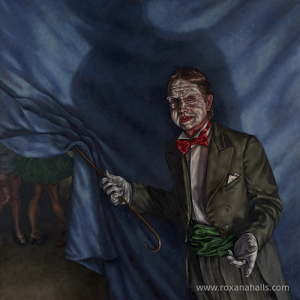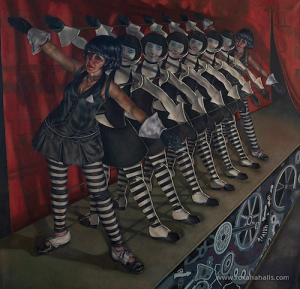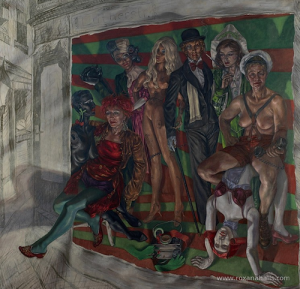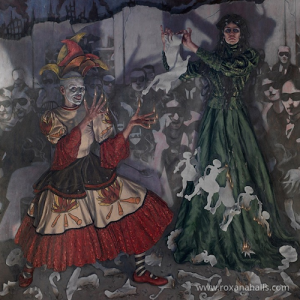 home
about
artists
exhibitions press
contact
purchase
home
about
artists
exhibitions press
contact
purchase |
|||||||||||
|
ROXANA HALLS
http://www.kabarett.it/roxana-halls-oil-on-cabaret/ Let’s meet Roxana Halls, English painter, winner of the prestigious Villiers David prize in 2004, and charmed by the Berlin cabaret. In this interview she talks about her project Roxana Halls’ Tingle-Tangle, that was exhibited at the Royal National Theatre, South Bank, London in 2009. First of all, let’s talk about the title of this exhibition: Roxana Halls’ Tingle-Tangle. Why is your name part of the title?
The
decision to incorporate my own name into the title began, in the
latter stages of the Tingle-Tangle project,
to be a very logical means by which to
describe the choices that I had madein
developing this work. What was the first inspiration for this topic?
Theatre & performance have always been inspiring for me, and much of
my work is embued with a haunting ‘backstage’ atmosphere. My
studio is based in the saloon bar of an old South London theatre,
and while I had been working in the space for several years before
commencing the “Tingle-Tangle” project, it was only a matter of time
before the ambience of my surroundings were to inspire a fully
realised project. The first character of your Tingle-Tangle is an Emcee, then in the next paintings we meet several other artists. But just two of them really existed: Grit e Ina van Elben. Why you’ve chosen to portrait them?
Well,
I’m afraid I must contradict you there! Grit & Ina van Elben are
indeed some of the only actual 1920′s Berlin cabaret performers, but there
are others who are based upon real acts or people associated with
the scene.
And Mali & Ingel were the proprietors of a very lively lesbian bar in 1920′s Berlin, known to be popular with performers of the day, including I understand, Claire Waldoff herself! Some of the other characters have stage names like artists from a sideshow: another inspiration, along with circus and, maybe, a bit of Méliès cinema. Please, tell us about these different sources of inspiration. It’s interesting that you have noted Méliès as a possible inspiration. While it wasn’t a conscious one it’s certain to be true that he is just one among miriad artists I looked to while making this work. I don’t think there was a book or film or image of an artwork I was able to obtain that I didn’t absorb. Peter Jelavich’s Berlin Cabaret was my starting point, but from that point on there was more than I could mention. From Brecht & Weill’s Seven Deadly Sins to of course The Blue Angel, Mel Gordon’s Voluptuous Panic, Lisa Appignanesi’s The Cabaret, numerous UFA, Pabst & Lang films, the list is endless! Your Tingle-Tangle seems to be staged in a 20’s Berlin cabaret, but several paintings include elements of the subsequent decades (some costumes and the make-up of the characters). Why you’ve chosen to include them and how you’ve succeeded in maintaining a thematic coherence?
In
making my choices for performers in my cabaret my guiding principle
came to be determined by how best to describe the narrative arc
which came to be the defining thread of the whole enterprise, and it
is this arc which brings the troupe & their acts together, from
whatever period in time they came. Mali und Ingel’s characters seem to pop off from a poster to reality. But that reality seems to be just sketched. Why are the characters leaving their world and what’s going to happen to them?
The
painting “Mali und Ingel’s” appears at a crucial stage in the show’s
narrative, the point at which the
performers are beginning to literally break through the confines of
their expected roles & out of the backdrop itself.
Some of the Tingle-Tangle’s characters are a bit disturbing. Maybe the eeriest are Terina the Paper Tearer and Inferna the Human Torch, that are tearing and burning human shaped papers. How were these characters born?
Much
of my work is tinged with a certain dark
ambience & sinister humour &
so here in the Tingle-Tangle‘
pictures I gave that tendency full expression. I’m secretly glad
that Terina & Inferna appear to be the most unsettling ladys in the
show because they
are both self-portraits!Terina
as I’ve previously explained was a real English music hall
performer, but Inferna was my own creation. During my travels I
found an extraordinary dress, as you see in the painting, with red
lace and painted flames, and knew I had to try to develop a
character who would be a match for this most unusual garment! All the acts portrayed in the paintings seem to be set on a big stage. But in the last painting the show is ended, leaving a tiny stage and just one empty chair for the audience. Is it the magic of the theatre?
Yes,
indeed it is the magic of the theatre, the impossibility of what has
just transpired. This image is also intended to underscore the sense
that what you have witnessed is perhaps your
own cabaret show,
and that your response to the evening’s events can only be your own,
subjective & ultimately solitary. The Tingle-Tangle exhibition has a parallel project: a photographic series created in collaboration with photographer Matthew Tugwell. Please, tell us about it.
This
corresponding series of images was born out of the desire to fully
utilise the wonderful exhibition space where the project was first
shown, The Royal National Theatre, South Bank, London, but came to
feel like an integral part of the whole enterprise. In several others of your paintings we can see velvet curtains, masks, costumes, wigs and other similar elements from theatre. Why does the theatre fascinate you?
From
my earliest days I have found a fascination with all things
theatrical, and as a child up until
I discovered oil paint I was determined that I would one day become
an actor.
All such ambitions fell away as soon as I first painted, and since
then there has been nothing which could captivate me in the way that
painting has and continues to do & I have a deeply felt commitment
to the painted image & all that it can achieve.
Please, tell us about your next exhibitions.
My
forthcoming show, Appetite,
is to be exhibited at
Hayhill Gallery, Baker St, London from the 26th August to the 27th
September 2014. |
|||||||||||
|
Here’s a short film by Martin Perry about Roxana Halls’ Tingle-Tangle.
|
|||||||||||
|
|
E-mail: info@hayhillgallery.com |
||||||||||




